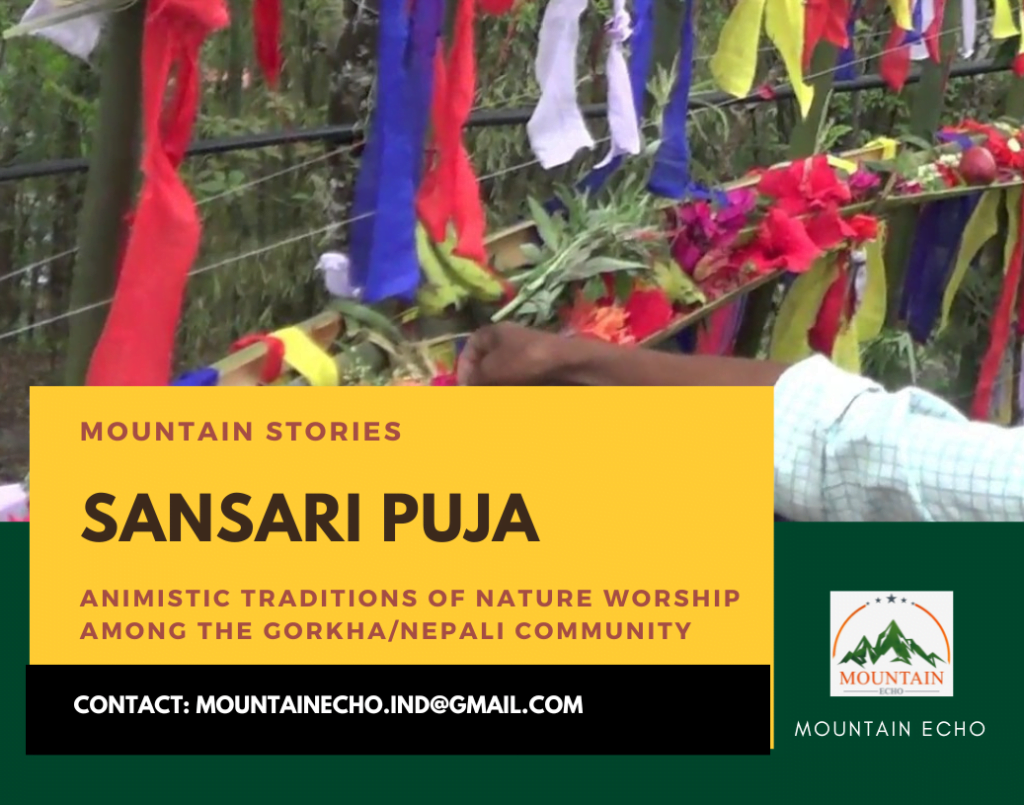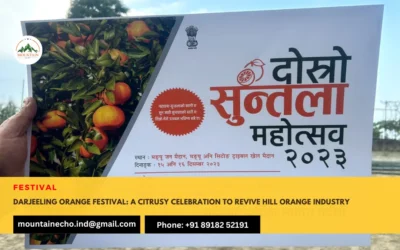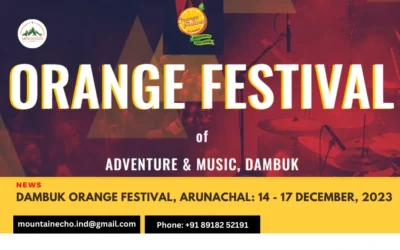- Pingback: Dashain Festival of the Gorkhas – Gorkha Book Trust
Sansari Puja: Localization of the rituals over time
Sansari Puja, celebrated by the Gorkha or Nepali community, is one of the different ways mountain people show their gratitude to mother nature and respect to their ancestors. Mountain-dwelling communities share a very close and profound relationship with Mother Nature. This connection is rooted in their daily lives, cultural beliefs, and a deep appreciation for the natural environment that surrounds them.

Mountain communities rely on the resources provided by nature for their survival and livelihoods – fertile soil, clean water, timely rains, forests, and diverse ecosystems. They recognize that their well-being is intricately linked to the health and balance of the ‘Nature’ around them. Even the festivals and celebrations of the mountain communities are tied to the agricultural cycles which reflects the people’s reliance on farming and the changing seasons.
People living in the mountains also know the raw power and unpredictability of natural forces such as avalanches, storms, and landslides. Thus, the mountain communities develop a deep respect for these ‘forces of nature’ and a humble acknowledgment of their vulnerability in the face of nature’s might.
These festivals differ in their rituals depending on the specific mountain community, cultural traditions, and agricultural practices involved. However, the common thread is the celebration of agriculture and showing respect for the benevolent nature for blessing the food.
Sansari Mata – the benevolent mother of all creations
Sansari Puja is one such popular rituals for worshipping the nature/creator, by invoking Sansari Mata/Mai, the benevolent mother who provides for the sustenance of the people. During the Puja, prayers are made to the mother for timely rain, abundant produce, and protection from any dangers in the year ahead.
It must be noted that ‘Sansari Mata’, the benevolent Mother, is not affiliated to any religious beliefs or faith. She is a Goddess of the community and all community members, irrespective of their religion and beliefs, join the festivities.
The animistic rituals in a Sansari Puja are performed by community elders along with the traditional shamans and spiritual healers (Dhami, Jhyakri, or Ojha). The local shamans are believed to have deep knowledge of traditional rituals, chants, and healing practices. They are believed to have a connection with spirits, ancestors, and deities, and possess the ability to communicate with them.
The Puja is usually a community affair and is performed away from human habitation, such as open fields, riverbeds, or jungles. The place of worship is constructed using bamboo sticks (called ‘lingos’ in Nepali) with banana leaves below. Colourful dhajas (small pieces of cloth) are tied along the bamboo sticks, the banana leaves are washed, cleaned, and decorated.
They perform the rituals and make offerings to please Sansari Mata and seeking forgiveness for any violations of nature the community may have made. Depending on the geography, food habits, and local traditions, every household make offering to the Goddess during the puja, in most cases the produces from their farms. In many places, wine, alcohol, eggs are offered and even animal sacrifices held.
Localization of Sansari Puja Rituals
The customs, social rituals, and traditions of performing the Sansari Puja have changed, evolved, and localized over time due to various factors, including geographical, cultural, and historical influences.
Regional deities are incorporated into the Sansari Puja, and specific rituals and offerings dedicated to the local deities. This localization reflects the unique religious and mythological traditions that influenced by local customs, cultural practices, and spiritual beliefs.
For example, a Sansari Puja held in Darjeeling, the priests will invoke local deities like Sinchel Devi, Mahakal, or Teesta-Rangget rivers, Kanchanjunga, etc. While the chants in Sansari Puja held at Assam invoke Brahmaputra, and the Raja-Rani of Assam, Sansari Puja in Manipur invokes Manipuri deities, Kings, and natural surroundings such as – Goddess Panthoibi, Koubru mountain, Loktak, King Pakhangba, Barak River, Shirui Hill, Imphal river, and so on.
These localized beliefs and spiritual integration contribute to the unique character and practices of the Sansari puja in different areas.
However, it is important to note that while there may be localized variations in the Sansari Puja, the core essence of the puja, including its purpose, devotion, and seeking of blessings from Mother Nature, remains consistent in the Sansari Puja performed by Gorkha and Nepali community. The localization of the puja reflects the diversity and richness of the cultural tapestry within the community.
Sansari Puja – bring the community together
Besides the spiritual significance of the Sansari Puja, it also serves as a significant occasion for community bonding and fostering a sense of togetherness.
All members contribute to the Puja, irrespective of their religious beliefs, creating a sense of shared spirituality and reverence to our natural surroundings.
Sansari Puja is accompanied by community feasts, where people come together to share food and enjoy each other’s company. The community members contribute to prepare for the feast and such communal dining strengthens social bonds and promotes a sense of belonging.
For the young members of the community, Sansari Puja provides with an opportunity to actively participate in and contribute to learn and nurture a sense of pride in their cultural heritage.



